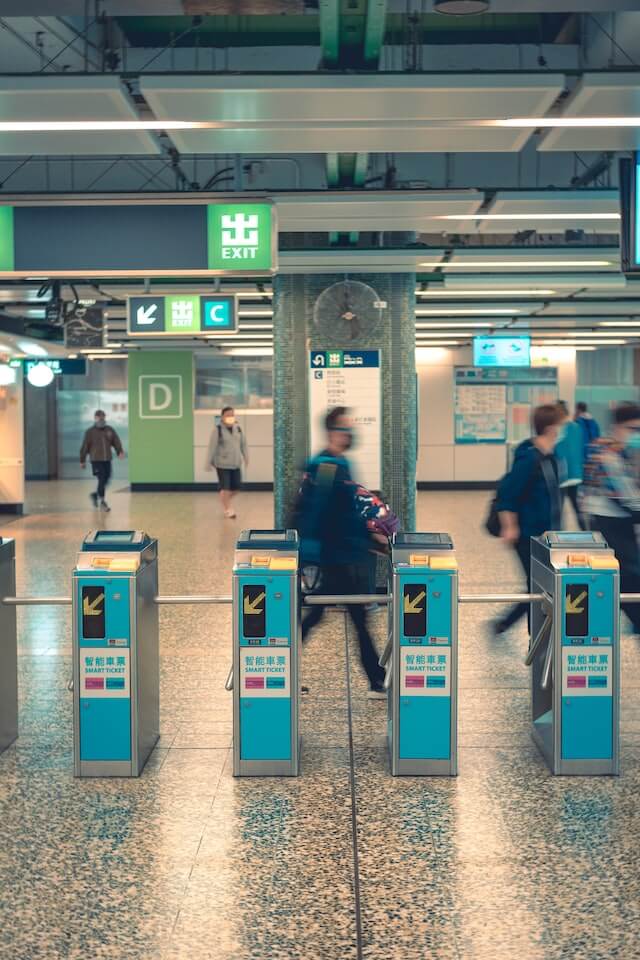Not long ago, taking the train in Japan meant squinting at posters on the wall and fumbling with paper maps. And half the time it would still end with an awkward conversation with a station attendant. Well, those days are long gone thanks to smart phones.
We did the downloading and the research. Here are the top 7 lifesaving train apps for Japan in 2024:
Whether you’re only expecting to take the occasional train or you’re planning on living on them during your time in Japan, these apps can make life a lot easier.
1. Japan Travel – Route, Map, JR
Best for tourists
Cost: Free with premium plan for $8.99 USD/month or $74.99 USD/year
Browser version can be found at navitime.co.jp/en/transfer/
English support: Yes
Google play link
iOS link
If you’re visiting Japan for the first time, this might be the ultimate app.
The layout is sleek, with helpful blog posts on topics like the new Ghibli theme park, trip itinerary ideas, and even coupons. And on top of all of that, the route searching and planning options are spot on.
If you have any type of JR Pass or Tokyo subway pass, you can plan your trip around that, too.
The premium version of the app packs quite a bit when compared with some other options on this list. It unlocks voice navigation, rainfall radar, alternative routes, and other bonuses like extra storage for travel plans and collections (customizable lists of destinations and activities that you can save from other parts of the app).
2. Norikae Annai (Japan Transit)
Best for those wanting no-frills English service
Cost: Free with “Plus Mode” available for ¥360/month, ¥1,000/90 days, or ¥2,900/year
Browser version can be found at world.jorudan.co.jp/mln/en
English support: Yes
Google play link
iOS link
Japan Transit, operated by the current train navigation king, Jorudan, might be the best option for overseas tourists visiting Japan.
It has support for JR Pass users, timetables for train stations, and special ticket packages that you can purchase in-app. Buying these means that you only need to flash your smart phone screen at train stations rather than using physical tickets and they often come with perks like tickets to nearby tourist attractions.
Subscribing to plus mode means a more convenient experience including information on platforms, train cars, different types of bullet train’s schedules, and your own personal route history.
3. Ekispert

Best overall app for expats
Cost: Free with premium version for ¥240/month or ¥2,400/year
Browser version can be found at https://roote.ekispert.net/ja/
or https://roote.ekispert.net/en/ for the English version
English support: Only for the website
Google play link
iOS link
Which app is better between Ekispert and the next item on this list is a tossup, but Ekispert edges slightly ahead because its free version can be a little more useful.
After searching for a route, you can sort by fast, cheap, comfort, and eco options. The last one helps you determine how big your carbon footprint is after riding the train.
The premium version is also a cheaper than Navitime and offers things like “drunk mode,” which makes stumbling (or rolling) home at the end of a long night of binge drinking a little easier. Unfortunately, it doesn’t have the option of total navigation, so you may want a maps app to guide you to and from the station.
4. Navitime
Best for those who want points for riding the train
Cost: Free with premium version for ¥400/month or ¥3,500/year
English version of the browser can be found above. The Japanese version is navitime.co.jp/
English support: Only for the website
Google play link
iOS link
Run by the same company that designed the Japan Travel app, Navitime is another great option for those living in Japan, with up-to-date information on train times and cancellations. Unfortunately, it’s only in Japanese, but if you can handle that there’s a lot to love.
The premium option unlocks the ability to get train mileage points by reporting on the status of trains (how many people are on the train, cancellations, etc.). You can then exchange these points for air miles or digital money.
Of course there are other perks to the premium plan like removal of ads and voice navigation. There’s also total navigation which provides maps and guidance based on different modes of transportation. This makes it a great tool for cyclists searching for bicycle-friendly roads.
5. Google Maps
Best for those not wanting to download extra apps
Cost: Free
Browser version can be found at google.com/maps
English support: Yes
Google play link
iOS link
Does this tech behemoth require an introduction? Probably not, but maybe their train function does.
When searching for directions from one destination to another, you can click the little train for the public transportation option. It’ll give you most of the information that these other apps provide, although the fares and train updates are occasionally inaccurate.

It’ll do most of what you want a train app to do. However, since it’s not specifically designed for trains, it can take a bit of work and doesn’t have full train timetables.
Side-note, be careful if you find yourself driving in Japan with Google maps as it can take you on some wild adventures down narrow roads.
6. City Rail Map
Best for those without a data plan
Cost: First map is free, after that you can unlock new maps for ¥480 or pay ¥2,400 to unlock all maps in the app
No browser version
English support: Yes
Unfortunately iOS only
iOS link
This isn’t just a great app for traveling by train in Japan, it’s also useful for world-wide travel, with at least 62 downloadable city maps.
To use it, download a city map while on wi-fi and take it out into the world with you. While off wi-fi, you can search train routes and the app will tell you where to make transfers to get where you need to go.
Unfortunately, the app doesn’t provide train times or fares, but it’s useful if you don’t plan on getting pocket wi-fi for your stay in Japan. Each map also comes with itinerary ideas that may give you some hidden gems to try out while visiting.
7. Suica/PASMO
Cost: Free, but requires charging with cash
Browser version isn’t applicable in this case, but you can get a physical card instead of the app.
English support: Unavailable
Suica Google play link
PASMO Google play link
Suica iOS link
PASMO iOS link

Suica and PASMO integrated circuit cards have both been making train travel in the Tokyo area more convenient for years, and they’ve taken it a step further with an app!
The idea behind these apps is simple: Top them up with money and tap your screen at train station IC card readers instead of using physical tickets or a plastic card.
Oh, and you can also go shopping with them and use them at vending machines that accept IC cards.
We’ve got a whole other article on these chargeable train passes if you want to learn more about the advantages and different types.
Which is Better, PASMO or Suica?
The PASMO IC card and app was designed for non-JR trains, while Suica is under the JR East brand. Both work on the same trains in the end, so it’s not necessary to choose one over the other. In the end, your decision of which card or app to go with may come down to whether you prefer pink or green!
Is Suica App Available in English?
Unfortunately, the Suica App is currently not available in English, so you’ll have to flex your Japanese skills to make it work. There used to be a SuicaEng app, but it’s been out of circulation for a while now.
What Happened to the HyperDia App?
For years, HyperDia was the gold standard among train navigation websites. And while they used to have an app, support for it was discontinued in 2022. Their website has also slowly become less and less useful over the years, with occasionally inaccurate train times and fares.
It’s even gotten to the point where the HyperDia homepage states, “Revision of fares and fees for some railway operators after October 2019 is not supported.”
Train timetable search was also disabled at the end of 2022.
What can I Use Instead of HyperDia?
For both browser and app options, the best alternative to HyperDia is either jorudan.com or navitime.com. Both offer excellent information on train times, fares, cancellations, and timetables.
Conclusion
The best train app for Japan depends on what your priorities are. If you’re visiting Japan for the first time, Japan Travel can be helpful with its functionality and itinerary ideas.If you’re living in Japan, you may want to put the nose to the grindstone and study enough of the language to make yourself comfortable with Navitime or Ekispert. It could be worth it, especially if you’re worried about missing trains on a wild night out!



